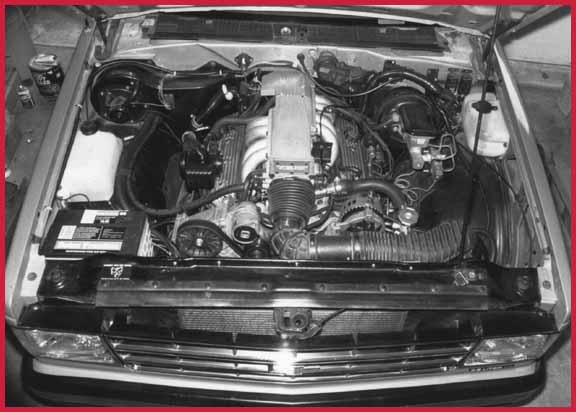S10 Introduction, Part 2. 1984 S-10 2WD Truck with 1989 305 TPI/700-R4

This is a 1984 S-10 2WD short-bed. It has a 1989 305 TPI and 700-R4 from a Camaro. This truck weighs about 3000 lbs and is very quick. Two twelve-inch electric cooling fans are mounted behind the radiator on custom brackets. The 85-89 Corvette radiator is actually mounted where the air-conditioning condenser would be on an air-conditioned S-10 Truck. Because of the lack of air-conditioning, and the attention to detail, the engine compartment looks very sanitary. Many people think this is a factory installation.
The owner purchased the V8 engine and transmission, and got all the parts required for the conversion before he removed the original V6/automatic powertrain. It took less than a week from the time he removed the V6 until the time he was driving it with the V8, but the owner is very talented, and very experienced with automotive work. Also, this is a fairly simple swap because it is a two-wheel-drive truck, and it is not air-conditioned. The engine is in the "forward" position, and the driveshaft is stock. At the time of this photograph, this truck had been driven over 60,000 miles.

We put a 1989 350 TPI into this 1985 4X4 S10 Blazer for a magazine article. As you can see, it's a tight fit. Due to space limitations, cooling is the biggest problem with the V8 S-10 conversions, especially on the 4X4 models. A lot of information in the cooling system chapter came from this conversion. This conversion took two very long weeks to complete.
We installed an NOS® nitrous oxide system, and ran it in the quarter mile. In 4-wheel-drive high-range, it ran 13.7 at 95 mph with 235/75-15 Goodyear All Terrain tires. Without the nitrous, it runs 15.2 at 88 mph. Remember, this is a 4-wheel-drive with skid plates and heavy off-road tires. It weighs 3900 lbs. What amazed most people is that the stock axles and transfer case handled the power without breaking. To further demonstrate how strong these parts are, we chained the truck to an immovable object (otherwise known as a one-ton crew cab dualie) and smoked all four tires. The tires actually dug holes in the asphalt.
With the original carbureted 2.8 V6, 700-R transmission and 4.11 gears, the truck averaged 18 mpg, and took forever to do 0-60 mph. The truck now averages about 15 mpg, but it is a lot more powerful and the drivability is much better than with the original engine. Installing 3.42 gears would probably bring the average gas mileage up to 18 mpg.
In case you are wondering about the custom wheels, they are off a 1990 Jaguar XJ-6 and they bolted on with no adapters, but they did require special lug nuts.
At the time of this writing, the truck has over 200,000 miles, and has been driven over 60,000 miles with the V8. The original rear-end required replacement at about 170,000 and the radiator has been replaced twice: once when the fan contacted the lower radiator support (see page 10-1), and another time when the water pump bearing wore out and the fan contacted the radiator. Read the chapter on the cooling system very carefully for important information on fan/radiator clearance.
And then there is the time the engine seized when the hose going to the remote oil filter failed. Be sure to use the correct hoses for the application, and check them regularly to be sure they don't get brittle! Or use the offset oil filter adapter (page 3-10), and don't worry about the hoses.

